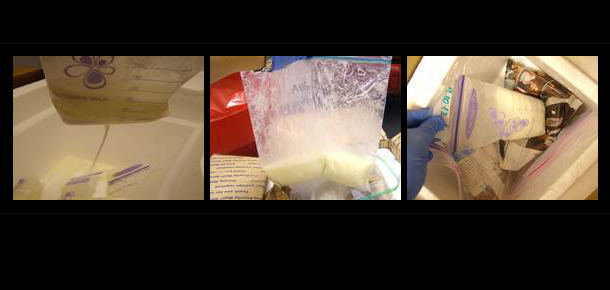A study that is out today in the November issue of Pediatrics, has found that samples of human breast milk, purchased online, overwhelmingly contained potentially harmful bacteria.
Dr. Sheela Geraghty, the senior author on the study and director of the Center for Breastfeeding Medicine here at Cincinnati Children’s first noticed, and indicated a need to understand, the practice of buying and selling breast milk in 2011 when it became clear that these on-line transactions were becoming common.
An increasing number of milk sharing websites and Facebook pages are popping up regularly and are indication that more mothers are looking for another mother’s breast milk to feed their babies. It’s also indication that many women, for varying reasons, have excess milk.
Dr. Geraghty says that the idea of women breastfeeding children other than their own is not new by any means, but there are safe ways to do it. The Human Milk Banking Association of North America (HMBANA) has more than a dozen member milk banks across the United States and Canada, which promote and facilitate safe, regulated milk donation and distribution to babies, often in NICUs, who have great need for the milk. Unfortunately as the practice of selling the milk has become more widely accepted in the parenting community, donations to milk banks have dropped significantly. At points even leading to a shortage of supply for the babies in NICUs.
Dr. Geraghty and her colleagues believe that the mothers who are participating in online milk sharing are by and large well-intentioned and believe they are doing the right thing. The most concerning part of the process seems to be in the shipping. It is impossible to know what will happen to a package of carefully expressed, stored and packaged milk when it leaves your possession to travel to an awaiting baby.
Of the 102 samples that the research team purchased and collected, nearly 90% arrived above the recommended frozen temperature for safe handling of breast milk. About 45% arrived above the recommended refrigerated temperature – meaning that milk was already, upon arrival, in a danger zone for bacterial growth. Several shipments arrived with milk leaking from the packaging.
So, what does this all mean? Dr. Geraghty says it means that it’s just too dangerous to try it.
If you are trying to breast feed an infant and don’t feel that you are producing adequate milk, please know that there are resources available to help you. Most maternity hospitals have lactation consultants on staff who can help you during a hospital stay and also take appointments on an outpatient basis. If you are in the Cincinnati area, Dr. Geraghty and her colleagues at the Center for Breastfeeding Medicine have appointments available for breastfeeding consultation at the main hospital, Mason, Northern Kentucky, and Green Township locations. Mothers and babies do not need a referral and can be seen at any time during breastfeeding. Mothers and babies are seen together at the appointments and the visits take about 1 hour. Appointments can be made by calling 513-636-2326.
And if you are a mother who has extra milk, the best way to ensure that your milk will reach a baby in need is to donate the milk to one of the HMBANA member milk banks . Cincinnati Children’s is a drop off site for the Mother’s Milk Bank of Ohio and you can find out more information on milk donation here by calling 513-636-2326.
Ultimately, it’s hard to tell how prevalent the online breast milk transactions are, and additional research is still needed to fully understand the scope of the situation, but it is clear that sharing, buying and selling breast milk online is not advisable and we hope that the findings of this study, and the awareness the resulting media attention brings, will deter the practice and lead to greater participation in safe milk sharing practices.





